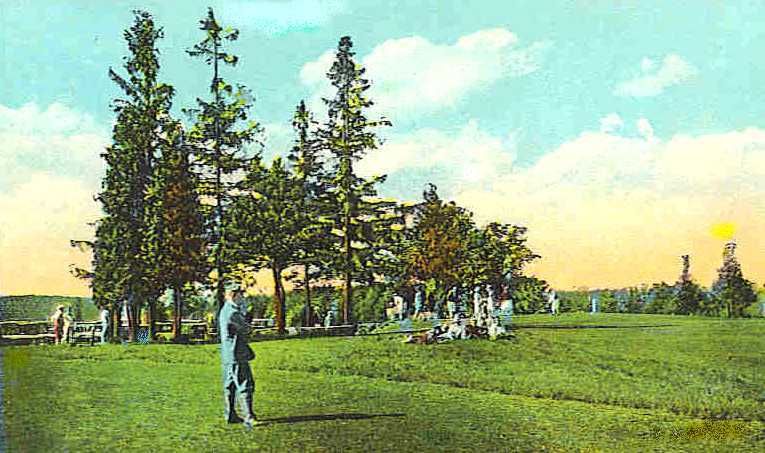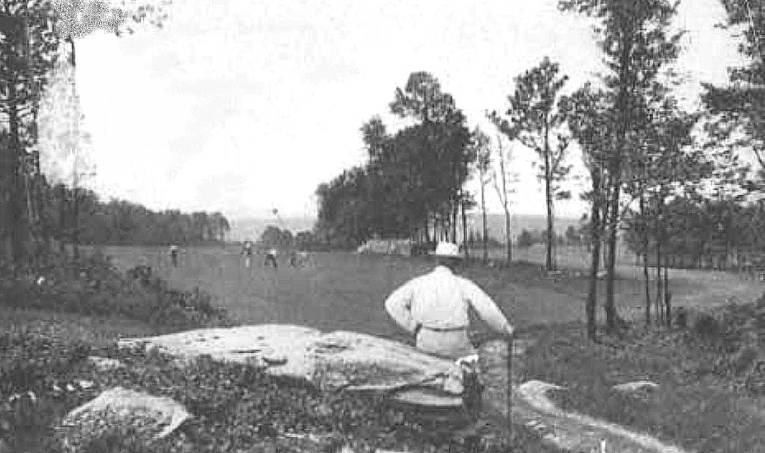The EMCC Story
Eagles Mere Country Club, founded in 1911 as the Eagles Mere Golf Club, has a rich history and a bright future.
Eagles Mere Country Club, home to a spectacular William S. Flynn designed course, is located in a small resort town, lovingly referred to as “the Town that Time Forgot” in Pennsylvania’s picturesque Endless Mountains. The Club began as a center for golf and social events. It continues to be a hub of golf and social activity and is now also home to a growing community of pickleball players.
BEGINNINGS
Approximately 2 years after the Club formed, the course opened its first 6 holes on June 17,1913. Later in the same year, Eagles Mere Golf Club joined the USGA. In 1915, a young William S. Flynn was hired as golf course architect. The course was built in stages, and all 18 holes were completed in 1923. Along with the completed course came Eagles Mere’s caddy camp.
1920's and 1930's
Golf was very popular in Eagles Mere, and tournaments were held there before and after the 18-hole course was finshed. During the 1920’s the course was a popular place to be, drawing many to the mountain; the Clubhouse was a site for social events and formal dances; and the tennis courts were busy, though not as much so as the true hub of tennis in Eagles Mere, then and now, the Crestmont. The caddy camp, Camp Kerodoki opened in 1923 and ran through the end of the 1957 season. The camp’s name was a conglomeration of some of the names of Club leaders. The camp was worked by Boy Scouts from Philadelphia who lived, worked, and played at the Club.The first nine holes of a second course were built before the stock market crashed in 1929. Work continued after the crash, but holes 11-18 were never finished. The partial course was available for play through 1934, but as the number of golfers declined, the Number Two Course was abandoned and portions of that property have since been sold.
 |
 |
1940’s-1950’s
Entering the 1940’s as the United States recovered from the Great Depression, golf on our 18 holes became more popular and Camp Kerodoki housed boy scout caddies on premises. Eagles Mere itself remained fairly formal. To dine at the Club, men wore jackets and ties and women, nice dresses.
On May 31, 1941 life in Eagles Mere was disrupted when the Hotel Raymond burned down. It was the worst fire in Eagles Mere History. The Hotel Raymond was never rebuilt.
December 7, 1941 shook more than just Eagles Mere, when the Japanese attacked Pearl Harbor, and the United States found themselves in World War II. The Eagles Mere Hotels, uncertain what would happen to business due to the effects of the war and rationing, advertised themselves as an escape. The town’s business continued through the war thanks to the availability of train travel to nearby muncy and many people wanting to leave the cities when they could.
One feature of the 1940’s Eagles Mere Golf Club that did not stick around to current times was the slot machine in the Golf Professional’s Shop which dispensed golf balls to winners!
In the 1940’s and 50’s there was no practice range at the Club. It wasn’t until Golf Pro, Jimmy Lyons, came to the Club that golfers began using the 10th hole from the abandoned second course. In the 1940’s Pro, Bill Letnaunchyn, gave his lessons in the area that is now our pond.
While golf has always been the headliner here, tennis was quite popular at the Club in the late 1940’s, though the Crestmont was admittedly the hub of tennis activity.
In 1951, the Club formed a Junior Committee and began its first Junior Program.
In the early 1950’s there were many golfers in Eagles Mere. The Club was not private at the time, but a feature for the hotels in the town to attract visitors. As travel became easier, would be guests were branching out into other areas for their travel and the Club and town first began to experience difficulties. Part of the problem was that the second course, which had been abandoned, was still not paid for. It was this debt that led to the reorganization of the Club as the Eagles Mere Country Club in August of 1955.
The summer of 1957 was the final summer for Camp Kerodoki, which had been home to Philadelphia Boy Scouts every summer for 35 years.
William S. Flynn
Check back for more details on EMCC’s golf course architect, William Flynn.
Our Evolving Clubhouse
Check back for more details on the evolution of the EMCC Clubhouse which began as the Avery family farmhouse.